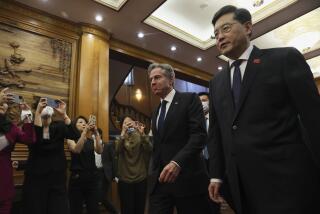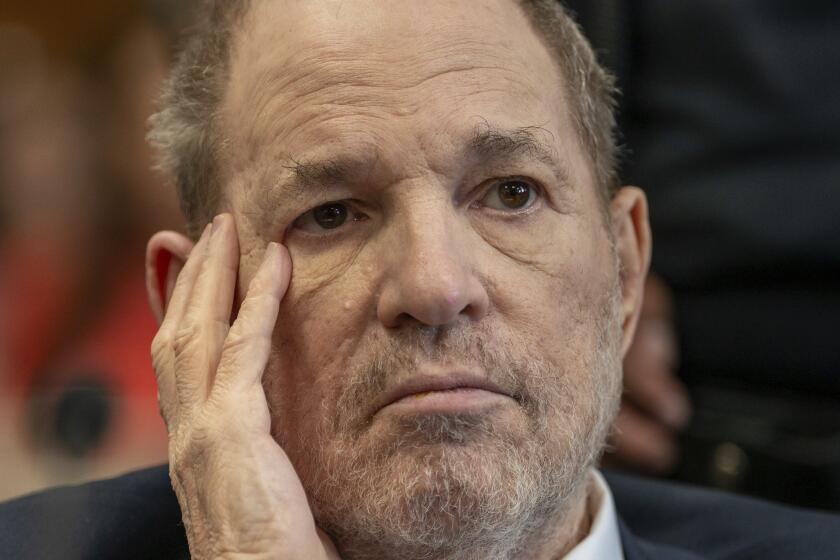Caught in their sights
They know Cameron Diaz uses obscene gestures, an open umbrella or a circuitous route to ruffle them. They’re wary of Brad Pitt because they know he may lob a hamburger if they get too close. They know Ben Affleck isn’t afraid of a high-speed chase and Charlize Theron won’t hesitate to fight back when she’s in a foul mood. They know that Nicole Kidman is sometimes listed in hotel logs as “Ruby Slipper” and Jude Law as “Mr. Blue.” They know Tom Cruise stays hidden unless he’s promoting a new movie. And after one of their own crashed his car into Lindsay Lohan’s Mercedes on Tuesday night, they know to handle her with kid gloves for a while.
They are the paparazzi, the almost universally despised satellites of the celebrity world whose mission is to capture those rare, unguarded moments that bring the fantasy so achingly close, dissolving the manufactured image and feeding our addictive appetite for voyeurism.
Don’t confuse these photographers with the well-groomed gents and ladies who populate the red carpet; by comparison, the paparazzi are commandos. They memorize license plates and celebrity pseudonyms. They pay relatives, personal trainers, valets and airline industry staff for tips. They hire helicopters, yachts, motorcyclists, even submarines to get their shot. Earlier this year, Kidman claimed two paparazzi bugged her Sydney estate.
Their savvy and chutzpah often help confirm the gossip that sells the magazines, boosts ratings and fuels the public’s obsession with celebrity. Whether it’s Jennifer Garner’s pregnancy, Lohan’s weight loss or Nick Lachey’s whereabouts, the paparazzi’s well-paid sources often guarantee them the unvarnished truth, the story behind the hype.
“They almost work as plainclothes cops or spies,” says Peter Howe, whose new book, “Paparazzi,” takes a thorough look at the “pap” phenomenon. “They’re sort of like photography’s unwanted relatives. And yet ... when the market for photojournalism is dwindling rapidly, these guys can’t produce enough work.”
When everything’s off the record, as it generally is in Hollywood’s image-conscious community, it’s the picture that sells the story. While representatives of Pitt and Jennifer Aniston talked about their amicable split and enduring love, those pap images of Pitt, Angelina Jolie and her son Maddox frolicking on a Kenya beach told another tale entirely -- and sold for about half a million dollars.
“They’re doing our version of investigative journalism,” says Peter Grossman, Us Weekly’s news photo editor.
*
Tenacity pays off
For his book, Howe spent two years researching the paparazzo phenomenon and interviewing some of the industry’s most successful veterans -- Phil Ramey, Ron Galella and Frank Griffin among them -- to understand this driven group. In the process, he learned that independent paparazzi can earn $1 million a year because of their unparalleled tenacity and, many would say, untethered moral code.
Some, particularly the younger photographers, are movie fans who get a thrill from being a part of the machine. Others see nothing but dollar signs. Some say celebrities deserve no privacy; it’s the price of fame. Others grapple with their role and even pity the stars. Some are fine dinner companions. Others, he says, are “borderline psychotic.” All of them, writes Howe, a former picture editor for the New York Times Magazine and former director of photography for Life magazine, are “blissfully unconcerned with the opinions of others.”
“What I most wanted to do was finally understand why we’re obsessed with celebrity. Where do these guys fit into the overall picture?” Howe said at a recent interview in Santa Monica. “What is the difference between [renowned street photographer Henri] Cartier-Bresson and a paparazzo who does exactly the same thing except with a specific group of people?”
As it turns out, the differences are quite stark. For example, it’s unlikely Cartier-Bresson ever dressed as a llama to blend into a herd grazing near his subject as the National Enquirer’s photographers did to capture Michael J. Fox’s wedding.
At the same time, though, the paparazzi possess unwavering devotion to their craft, says Howe. Of course they’re driven by the lottery-like payoffs a single image can produce, even if it’s out of focus and shot from a mile away. But earning their income means enduring almost unceasing vitriol from their subjects and going to extraordinary lengths to get their shots.
“The biggest thing to overcome is when someone turns around and says, ‘Get a life,’ ” says Griffin, a partner with Randy Bauer in L.A.-based Bauer-Griffin, one of the most prominent American paparazzo agencies.
L.A.-based master paparazzo Ramey told Howe war stories of the August weekend in 1969 he spent locked in a rat-infested boathouse to get exclusive photos of Richard Burton and Liz Taylor on their yacht. Steven Ginsburg, a Santa Monica bartender-turned-paparazzo, talked about the terrifying 120-mph car chase led by Affleck through Georgia, jumping curbs and cutting through parking lots.
Mustafa Khalili, a London-born Palestinian who dreams of being a war photographer, described being attacked by Kid Rock and nearly pushed into oncoming traffic when he tried to shoot the performer and Pamela Anderson after a concert. And after Marlon Brando knocked five of his teeth out, Galella would shoot the actor only while wearing a football helmet.
“We’re not in this job to make friends with them,” Ginsburg told Howe.
The profession is colored by swagger, but the ethics of the paparazzi vary according to the photographer. Some refuse to shoot the children of celebrities. Others shoot what they know will sell, no matter what. Many paparazzi prefer to capture the stars when they’re unaware of the camera, but few shy away from confrontation.
Still, there can be misgivings: Even paparazzi have feelings.
“At the end of the day, we’re all normal, and the sad thing about these superstars now is that it’s so hard for them to be,” longtime London-based photographer Duncan Raban told Howe. “Does the paparazzi stuff make them into bigger stars? I guess it does, but I really do genuinely feel sorry for them.”
*
Increasing numbers
Most paparazzi work in Los Angeles. The stars live here and the city’s car culture and warm weather create more colorful images of lightly clad celebrities out and about. Paparazzi eat and breathe their work, scoping sidewalks, windshields and cafes for famous faces. They live in their cars, sometimes staking out celebrity homes for days or weeks at a time, hoping to catch that “morning after” shot of the couple of the moment.
And while this business has always been competitive, the circle of paparazzi working in L.A. has increased in 10 years from a handful of photographers to scores of them. There are dozens of paparazzo agencies in L.A., vying for images of about 50 A-listers, which makes it much more difficult to land the high-value exclusive photos.
In fact, Griffin believes the photographers are so hungry for them that the environment is primed for another paparazzo-involved tragedy like the Paris car accident that killed Princess Diana in 1997. Earlier this week, Los Angeles police arrested 24-year-old Fame Pictures Inc. contractor Galo Cesar Ramirez on suspicion of felony assault with a deadly weapon for allegedly intentionally crashing his car into Lohan’s Mercedes during a rush-hour chase on West 3rd Street in Los Angeles.
In April, Jennifer Lopez narrowly avoided a car crash when, she says, a paparazzo cut off her driver. Later that month, as Reese Witherspoon left her gym, she was swarmed by paparazzi, who, police say, nearly forced her off the road as they followed her home and blocked access to her front gate when she arrived.
“The demand has created a lot of cowboys and caused less-reputable people to come out to this town,” says Griffin, a Brit who’s been L.A.-based for 15 years. “Now I’m having to send my photographers out of town.”
Consequently, the paparazzi “are spotting each other as easily as they spot the celebrities,” says Grossman. If one photographer takes off from a location suddenly, he’s sure to have a competitor close at his heels.
For that reason, the real pros -- the independents -- avoid the usual celebrity haunts like the Ivy on Robertson Boulevard because so many other paparazzi stake out the place. Instead, they rely on their sources to tip them off to the whereabouts of stars, from out-of-town hotels to airport terminals to parks and even hospitals.
“I carry lots of cash with me just to pay sources who have good information,” says Griffin.
Tabloids and magazines often pay paparazzo agencies an hourly rate to shoot a specific assignment, such as a celebrity wedding or a star’s visit to the Kabbalah Centre. But photographers also generate their own stories and then later negotiate prices with publications and TV shows all over the world. Us Weekly director of photography Brittain Stone told Howe that the magazine receives 45,000 to 50,000 images each week, three-quarters of which are paparazzo shots.
Legions of amateurs, wielding digital and cellphone cameras, routinely pitch their photos to the media themselves. While publication of these photos is still relatively rare, this burgeoning group adds to the already swelling ranks of professionals. Howe’s book details the case of one unnamed amateur who happened to get married the same night in the same Las Vegas chapel as Britney Spears and Jason Alexander, her first husband of just 55 hours. He got photos of the newlyweds and sold them for about $300,000.
More and more, the paparazzi are reshaping the traditional model of celebrity publicity by forcing the stars to play their game. Celebrities often try to ward off the swarm by making themselves available at the right time, thereby diminishing the value of unguarded shots.
Many paparazzi believe Gwyneth Paltrow and Chris Martin staged the photo of Martin rubbing her abdomen as the two left her doctor’s office, an implicit sign of Paltrow’s pregnancy. And after they had the baby, Paltrow took a very public stroll with her infant for the cameras as a way to quell interest in their photos. Soon after her breakup with Billy Bob Thornton, Jolie appeared at a public park with her toddler son, burnishing her role as a caring mother.
Ultimately, publicists can’t control the paparazzi. As a result, they try mainly to prevent a client’s overexposure, which may mean a hermetic lifestyle, strategic travel plans and disguises. Some A-list stars use “stick cars” that tail them and teams of security guards to keep paparazzi at bay. When those don’t work, they hire portrait photographers to shoot “paparazzi-like” photos of a star or alert paparazzi to their client’s whereabouts when it can help boost a career. Griffin says he’s convinced shots of Pitt and Jolie in Kenya were the result of a publicist’s call.
“There’s no way you could have a photographer on a beach in Mombasa just waiting for Angelina Jolie and Brad Pitt to walk by,” he says. “I’ve been trying to get that shot, or something like it, for 18 months.”
More to Read
Start your day right
Sign up for Essential California for news, features and recommendations from the L.A. Times and beyond in your inbox six days a week.
You may occasionally receive promotional content from the Los Angeles Times.






